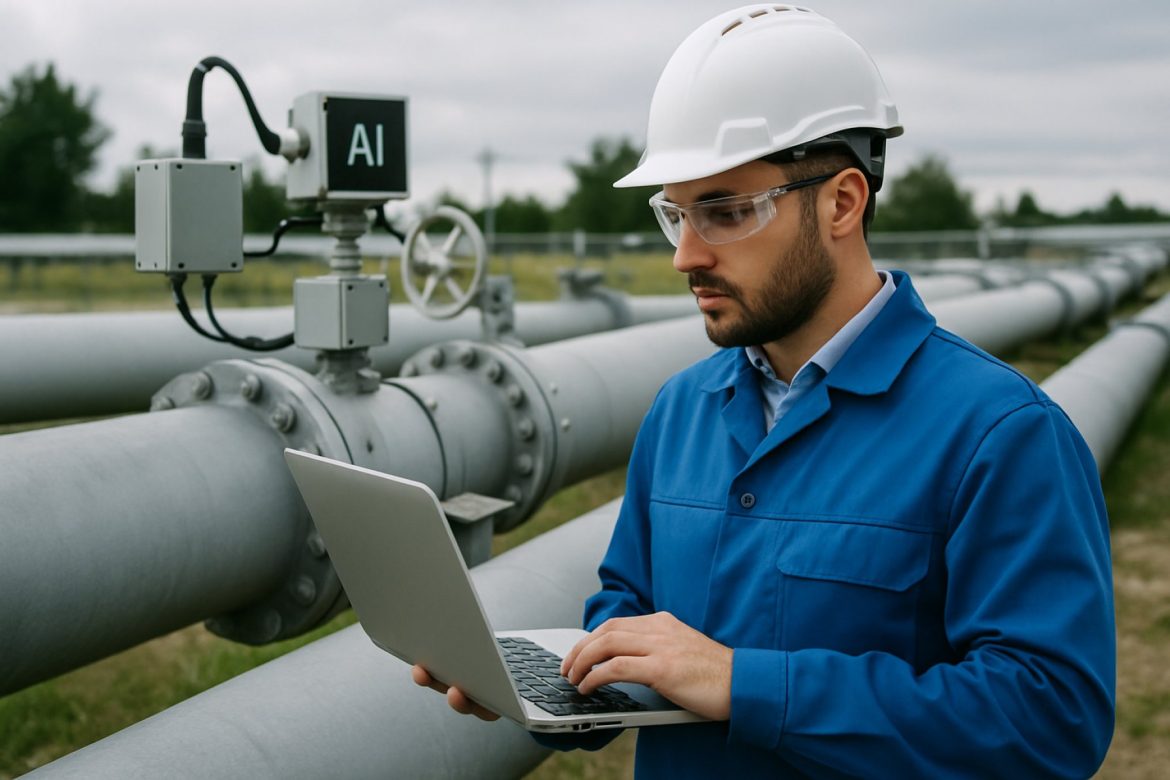Pipeline Integrity Engineering Market Report 2025: In-Depth Analysis of Technology Advancements, Market Dynamics, and Global Growth Projections. Explore Key Trends, Regional Insights, and Strategic Opportunities Shaping the Industry.
- Executive Summary & Market Overview
- Key Technology Trends in Pipeline Integrity Engineering
- Competitive Landscape and Leading Players
- Market Growth Forecasts (2025–2030): CAGR, Revenue, and Volume Analysis
- Regional Analysis: North America, Europe, APAC, Latin America, Middle East & Africa
- Future Outlook: Innovations and Strategic Roadmaps
- Challenges, Risks, and Emerging Opportunities
- Sources & References
Executive Summary & Market Overview
Pipeline integrity engineering is a specialized discipline focused on ensuring the safe, reliable, and efficient operation of pipelines that transport oil, gas, water, and other critical fluids. As of 2025, the global pipeline integrity engineering market is experiencing robust growth, driven by aging infrastructure, stringent regulatory requirements, and heightened environmental and safety concerns. The sector encompasses a range of activities, including inspection, monitoring, risk assessment, maintenance, and the deployment of advanced technologies to detect and mitigate potential failures.
According to MarketsandMarkets, the global pipeline integrity market is projected to reach USD 10.3 billion by 2025, growing at a CAGR of 4.1% from 2020. This growth is underpinned by increasing investments in pipeline infrastructure, particularly in North America, the Middle East, and Asia-Pacific, where energy demand and cross-border pipeline projects are expanding. The United States, for example, continues to lead in pipeline mileage and integrity management initiatives, supported by regulatory frameworks from agencies such as the Pipeline and Hazardous Materials Safety Administration (PHMSA).
Key market drivers include:
- Aging Pipeline Networks: Many pipelines worldwide are operating beyond their original design life, necessitating advanced integrity management to prevent leaks, ruptures, and environmental incidents.
- Regulatory Compliance: Governments and regulatory bodies are imposing stricter standards for pipeline safety, requiring operators to adopt comprehensive integrity programs and regular inspections.
- Technological Advancements: Innovations such as smart pigging, real-time monitoring sensors, and data analytics are enhancing the ability to detect corrosion, cracks, and other anomalies before they escalate into failures.
- Environmental and Social Pressures: Public scrutiny and environmental activism are compelling operators to prioritize safety and transparency in pipeline operations.
Major industry players, including Baker Hughes, ROSEN Group, and T.D. Williamson, are investing in R&D and expanding their service portfolios to address evolving market needs. The competitive landscape is characterized by strategic partnerships, mergers, and acquisitions aimed at enhancing technological capabilities and geographic reach.
In summary, pipeline integrity engineering is a critical and rapidly evolving market segment in 2025, shaped by infrastructure challenges, regulatory dynamics, and the imperative for operational excellence and environmental stewardship.
Key Technology Trends in Pipeline Integrity Engineering
Pipeline integrity engineering is rapidly evolving, driven by the need for safer, more efficient, and environmentally responsible pipeline operations. In 2025, several key technology trends are shaping the field, reflecting both regulatory pressures and advances in digitalization.
- Advanced In-Line Inspection (ILI) Tools: The adoption of high-resolution smart pigs equipped with ultrasonic, electromagnetic, and magnetic flux leakage sensors is expanding. These tools provide granular data on corrosion, cracks, and geometric anomalies, enabling more accurate risk assessments and targeted maintenance. Companies such as Baker Hughes and ROSEN Group are at the forefront, offering multi-technology ILI platforms that integrate data analytics for real-time decision-making.
- Artificial Intelligence and Machine Learning: AI-driven analytics are transforming how pipeline operators interpret inspection data. Machine learning models can now predict failure probabilities, optimize inspection intervals, and automate anomaly detection. This trend is supported by digital platforms from providers like GE Digital and Cognite, which integrate data from sensors, drones, and historical records to deliver actionable insights.
- Remote Sensing and Aerial Surveillance: The use of drones, satellites, and LiDAR for external pipeline monitoring is increasing. These technologies enable rapid detection of third-party interference, ground movement, and vegetation encroachment, reducing the risk of undetected external threats. DroneBase and Maxar Technologies are notable players providing geospatial intelligence for pipeline corridors.
- Digital Twin Technology: Digital twins—virtual replicas of physical pipeline assets—are being deployed to simulate operational scenarios, predict asset degradation, and optimize maintenance. This approach enhances lifecycle management and regulatory compliance, with solutions from AVEVA and Siemens gaining traction among major operators.
- Robotics for Non-Piggable Pipelines: For pipelines that cannot accommodate traditional ILI tools, robotic crawlers and tethered inspection devices are being developed. These innovations, championed by firms like Inuktun Services, are expanding the reach of integrity assessments to previously inaccessible assets.
These technology trends are collectively enhancing the predictive, preventive, and responsive capabilities of pipeline integrity engineering, supporting industry efforts to minimize failures and environmental impact in 2025 and beyond.
Competitive Landscape and Leading Players
The competitive landscape of the pipeline integrity engineering market in 2025 is characterized by a mix of established multinational engineering firms, specialized service providers, and technology innovators. The sector is driven by increasing regulatory scrutiny, aging pipeline infrastructure, and the integration of advanced digital solutions for monitoring and maintenance. Key players are differentiating themselves through comprehensive service portfolios, proprietary technologies, and global reach.
Leading companies such as Wood plc, ROSEN Group, and Baker Hughes maintain strong market positions by offering end-to-end pipeline integrity management, including inspection, risk assessment, and repair solutions. These firms leverage advanced in-line inspection (ILI) tools, data analytics, and artificial intelligence to provide predictive maintenance and real-time monitoring, addressing the growing demand for proactive asset management.
Specialized service providers like T.D. Williamson and Applus+ focus on niche segments such as pigging services, leak detection, and non-destructive testing. Their expertise in specific technologies allows them to compete effectively against larger players, particularly in regions with unique regulatory or operational challenges.
The market is also witnessing increased participation from digital technology firms and startups, which are introducing cloud-based platforms, IoT-enabled sensors, and machine learning algorithms for pipeline health monitoring. Partnerships and strategic acquisitions are common, as established engineering firms seek to integrate these digital capabilities into their service offerings. For example, DNV has expanded its digital pipeline integrity solutions through collaborations and investments in software development.
- North America remains the largest regional market, with stringent regulatory requirements and extensive pipeline networks driving demand for integrity services. Major players have established regional hubs to serve clients in the U.S. and Canada.
- Asia-Pacific is emerging as a high-growth region, fueled by new pipeline construction and increasing awareness of safety standards, attracting both global and local service providers.
- Competitive differentiation is increasingly based on the ability to deliver integrated, data-driven solutions that reduce downtime and extend asset life.
Overall, the pipeline integrity engineering market in 2025 is marked by consolidation among leading players, rapid technological innovation, and a shift toward digital, predictive maintenance models, as companies strive to address evolving industry challenges and regulatory expectations.
Market Growth Forecasts (2025–2030): CAGR, Revenue, and Volume Analysis
The pipeline integrity engineering market is poised for robust growth between 2025 and 2030, driven by increasing investments in energy infrastructure, stringent regulatory requirements, and the ongoing need to ensure the safety and reliability of aging pipeline networks. According to recent market analyses, the global pipeline integrity market is projected to register a compound annual growth rate (CAGR) of approximately 5.8% during this period, with total market revenues expected to reach over USD 12.5 billion by 2030, up from an estimated USD 8.9 billion in 2025 MarketsandMarkets.
Volume analysis indicates a steady increase in the deployment of integrity management solutions, including advanced inspection technologies, monitoring systems, and data analytics platforms. The number of pipeline inspection projects is forecasted to grow at a CAGR of 6.2%, reflecting heightened demand for in-line inspection (ILI), non-destructive testing (NDT), and real-time monitoring services Fortune Business Insights. This growth is particularly pronounced in regions with extensive pipeline networks, such as North America and the Middle East, where operators are prioritizing asset integrity to minimize environmental risks and operational disruptions.
Revenue segmentation by service type reveals that inspection and monitoring services will account for the largest share of market growth, followed by maintenance and risk assessment services. The adoption of digital technologies—such as artificial intelligence, machine learning, and IoT-enabled sensors—is expected to accelerate, enabling predictive maintenance and more efficient integrity management workflows Grand View Research.
- North America: Expected to maintain the largest market share, driven by regulatory compliance and the modernization of legacy infrastructure.
- Asia-Pacific: Anticipated to exhibit the fastest CAGR, fueled by expanding pipeline construction and increased energy demand.
- Europe: Growth will be supported by decarbonization initiatives and the integration of hydrogen and renewable gas pipelines.
Overall, the 2025–2030 period will see pipeline integrity engineering evolve from traditional inspection and maintenance toward a more data-driven, proactive discipline, with market growth underpinned by both regulatory imperatives and technological innovation.
Regional Analysis: North America, Europe, APAC, Latin America, Middle East & Africa
The global pipeline integrity engineering market is witnessing significant regional variations in growth, driven by differences in energy infrastructure, regulatory frameworks, and investment priorities. In 2025, North America remains the largest market, propelled by the extensive pipeline networks in the United States and Canada, stringent regulatory requirements, and ongoing investments in both oil and gas and emerging hydrogen pipelines. The U.S. Pipeline and Hazardous Materials Safety Administration (PHMSA) continues to enforce rigorous integrity management programs, prompting operators to adopt advanced inspection, monitoring, and data analytics solutions. The region also benefits from a mature ecosystem of service providers and technology innovators.
Europe is experiencing robust growth in pipeline integrity engineering, largely due to the continent’s energy transition strategies and the need to modernize aging infrastructure. The European Union’s focus on decarbonization and the integration of renewable gases, such as hydrogen, is driving demand for integrity assessments and retrofitting of existing pipelines. Regulatory bodies like the European Network of Transmission System Operators for Gas (ENTSOG) are setting new standards for safety and environmental compliance, further stimulating market activity.
The Asia-Pacific (APAC) region is emerging as a high-growth market, fueled by rapid urbanization, expanding energy demand, and large-scale pipeline projects in countries such as China, India, and Australia. Governments are investing heavily in new pipeline infrastructure and are increasingly prioritizing integrity management to prevent leaks, environmental incidents, and supply disruptions. According to Wood Mackenzie, APAC’s pipeline network is expected to expand significantly through 2025, creating substantial opportunities for engineering firms specializing in integrity solutions.
Latin America’s market is characterized by a mix of modernization efforts and new pipeline construction, particularly in Brazil, Argentina, and Mexico. While regulatory enforcement is less stringent than in North America or Europe, major operators are adopting best practices to reduce operational risks and comply with international standards. The region’s focus on oil and gas exports also necessitates robust integrity management to ensure uninterrupted supply to global markets.
In the Middle East & Africa, pipeline integrity engineering is gaining traction as countries invest in both upstream and midstream infrastructure. The Gulf Cooperation Council (GCC) states, led by Saudi Arabia and the United Arab Emirates, are deploying advanced integrity technologies to safeguard critical export pipelines. In Africa, new gas pipeline projects and cross-border initiatives are driving demand for engineering expertise, though challenges remain in terms of regulatory harmonization and skilled workforce availability (Oil & Gas Journal).
Future Outlook: Innovations and Strategic Roadmaps
The future outlook for pipeline integrity engineering in 2025 is shaped by rapid technological innovation, evolving regulatory landscapes, and the growing imperative for sustainability. As global energy demand persists and infrastructure ages, operators are increasingly investing in advanced solutions to ensure the safety, reliability, and efficiency of pipeline networks.
One of the most significant trends is the integration of artificial intelligence (AI) and machine learning (ML) into integrity management systems. These technologies enable predictive analytics, allowing operators to anticipate failures and optimize maintenance schedules. For example, AI-driven platforms can analyze vast datasets from inline inspection (ILI) tools, SCADA systems, and external sensors to detect anomalies and assess corrosion risks with greater accuracy than traditional methods. Companies such as Baker Hughes and ROSEN Group are at the forefront, developing digital twins and real-time monitoring solutions that enhance decision-making and reduce unplanned downtime.
Another area of innovation is the deployment of robotics and unmanned aerial vehicles (UAVs) for inspection and maintenance. Drones equipped with high-resolution cameras and sensors can rapidly survey remote or hazardous sections of pipelines, while robotic crawlers perform internal inspections without interrupting operations. These advancements not only improve safety but also lower operational costs and minimize environmental impact.
Strategically, the industry is moving toward holistic integrity management frameworks that integrate risk-based approaches and lifecycle asset management. Regulatory bodies, such as the Pipeline and Hazardous Materials Safety Administration (PHMSA), are updating standards to require more rigorous data collection, analysis, and reporting. This is prompting operators to invest in centralized data platforms and interoperable software that facilitate compliance and streamline audits.
Sustainability is also influencing strategic roadmaps. Operators are adopting materials and coatings that extend pipeline life and reduce emissions from leaks. There is a growing focus on hydrogen-ready pipelines and the retrofitting of existing infrastructure to support the energy transition. According to DNV, the shift toward low-carbon fuels will require new integrity assessment methodologies and cross-sector collaboration.
In summary, the 2025 outlook for pipeline integrity engineering is defined by digital transformation, automation, regulatory alignment, and sustainability. Companies that embrace these innovations and strategic shifts will be better positioned to manage risk, ensure compliance, and support the evolving needs of the global energy sector.
Challenges, Risks, and Emerging Opportunities
Pipeline integrity engineering in 2025 faces a complex landscape shaped by aging infrastructure, evolving regulatory demands, and the integration of advanced technologies. The sector’s primary challenge remains the prevention of leaks, ruptures, and environmental incidents, particularly as a significant portion of global pipelines approach or exceed their original design lifespans. According to American Petroleum Institute, over 60% of U.S. pipelines are more than 40 years old, increasing susceptibility to corrosion, material fatigue, and third-party damage.
Regulatory risk is intensifying as governments worldwide tighten safety and environmental standards. The Pipeline and Hazardous Materials Safety Administration (PHMSA) in the U.S. and the European Commission Directorate-General for Energy are both expanding requirements for real-time monitoring, data reporting, and rapid incident response. Non-compliance can result in substantial fines, operational shutdowns, and reputational damage.
Cybersecurity is an emerging risk, as digitalization and remote monitoring systems become ubiquitous. The 2021 Colonial Pipeline cyberattack underscored vulnerabilities in operational technology (OT) networks, prompting operators to invest in robust cybersecurity frameworks and incident response protocols. SANS Institute reports a 30% year-over-year increase in cyber incidents targeting energy infrastructure, highlighting the urgency of this threat.
Despite these challenges, significant opportunities are emerging. The adoption of advanced inspection technologies—such as high-resolution inline inspection (ILI) tools, machine learning-based anomaly detection, and drone surveillance—enables earlier identification of defects and more targeted maintenance. According to DNV, predictive analytics can reduce unplanned pipeline downtime by up to 25%, translating to substantial cost savings and improved safety.
The energy transition is also creating new avenues for pipeline integrity engineering. As hydrogen and CO2 transport infrastructure expands, engineers are developing new materials and integrity assessment protocols to address unique challenges such as hydrogen embrittlement and CO2 corrosion. International Energy Agency projects that by 2030, up to 20% of existing natural gas pipelines in Europe could be repurposed for hydrogen, driving demand for specialized integrity solutions.
In summary, while pipeline integrity engineering in 2025 is confronted by aging assets, regulatory scrutiny, and cyber threats, the sector is also poised for growth through digital innovation, predictive maintenance, and adaptation to new energy vectors.
Sources & References
- MarketsandMarkets
- Baker Hughes
- ROSEN Group
- T.D. Williamson
- GE Digital
- Cognite
- Maxar Technologies
- AVEVA
- Siemens
- Inuktun Services
- Wood plc
- Applus+
- DNV
- Fortune Business Insights
- Grand View Research
- ENTSOG
- Wood Mackenzie
- Oil & Gas Journal
- American Petroleum Institute
- European Commission Directorate-General for Energy
- SANS Institute
- International Energy Agency



